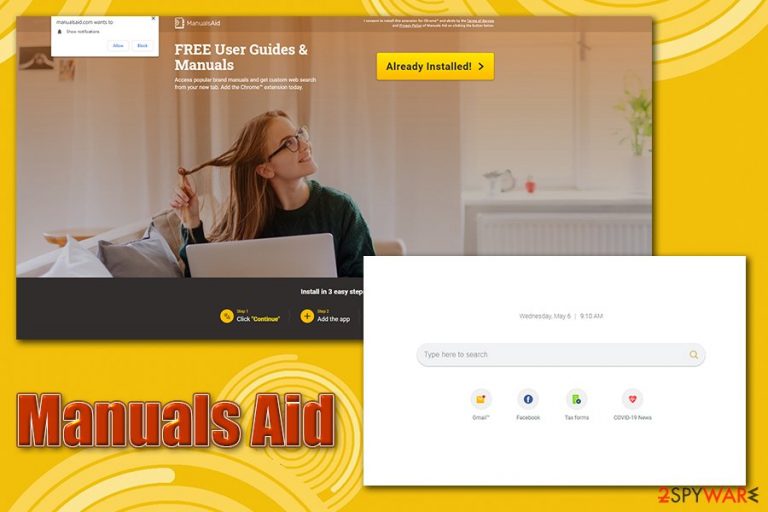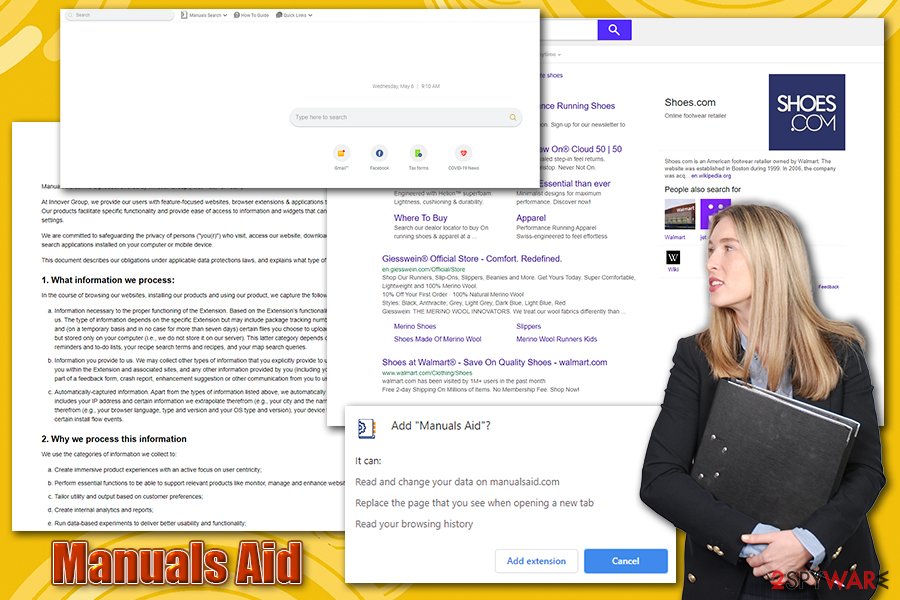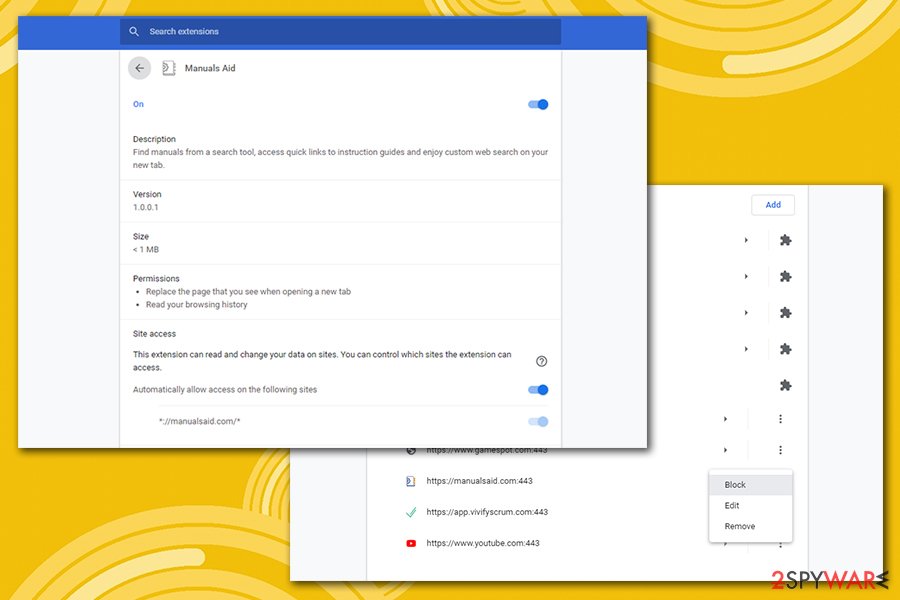Manuals Aid / Virus Removal Guide - Chrome, Firefox, IE, Edge
Manuals Aid Removal Guide
What is Manuals Aid?
Manuals Aid – a browser hijacker that seeks to know everything about you

Manuals Aid is a browser extension that users can download from official sources, such as Chrome Web Store, or install unintentionally via the ad, as well as software bundle. According to its developers, the app is a great tool to search for manuals easily from brands like Dell, Honda, Kenwood, LG, Sony, Casio, and many more. However, Manuals Aid extension comes with a package of side effects that most users would not be fond of.
As soon as Manuals Aid is installed on the web browser (Google Chrome, Mozilla Firefox, or MS Edge), it appends an extension and changes the homepage address, as well as the new tab URL to hxxps://manualsaid.com. Additionally, users will see a customized search engine that redirects all search results to Yahoo. However, suchlike results are not organic[1] and filled with sponsored ads at the top, which might change the way users browse the web entirely. Additionally, Manuals Aid collects a variety of information about users to serve targeted ads.
| Name | Manuals Aid |
| Type | Browser hijacker, potentially unwanted application |
| Infiltration | While users can download the app from the official browser stores, others may stumble upon the extension within |
| Symptoms |
|
| Risks | Installation of other potentially unwanted programs, personal data disclosure to unknown parties, distorted perception of online content and inability to find relevant information easily |
| Termination | You can uninstall the extension via your web browser by right-clicking on it; to get rid of the notifications, you should access web browser settings as we explain below; if you still see unwanted browser activities, check for potentially unwanted programs as per our instructions below or |
| Optimization | For best results, we recommend using FortectIntego |
Before we start analyzing the so-called Manuals Aid virus, there is another topic we would like to talk about. While there are many users who installed the add-on along with freeware downloaded from third-party websites, most probably stumbled across the official website, which advertises the extension. Upon accessing this website, users are displayed a notification prompt that asks to enable Manuals Aid notifications.
Those who allow notifications will soon notice that Manuals Aid ads are showing on their desktops, even if the web browsers are not functional. These can be extremely annoying, as they can disrupt computer operations during other activities other than browsing, e.g., watching movies or playing video games.
To remove Manuals Aid pop-up ads, you will have to access the settings of your web browser and disallow notifications from the site – we explain how to do that below. Additionally, uninstalling the extension should not be difficult – simply right click on the icon within the web browser and select “Remove.”
If ads and sponsored content do not stop, it may be that you have adware or other PUP installed on your system besides Manuals Aid, so check the instructions on how to eliminate them below. Note that you could eliminate the notifications from any site by resetting your web browsers – the action is recommended after the termination of PUPs. Additionally, we recommend performing a scan with anti-malware software, as well as FortectIntego repair tool to fix problems caused by malware.
What is particularly interesting about this browser hijacker and should warrant Manuals Aid removal for many is the information tracking practices. Unfortunately, not many users go to the depths of text that is presented in the Privacy Policy of apps, so most are unaware of what exactly is tracked about them.

While many other hijackers record information such as the IP address, ISP geolocation, and other non-personally identifiable data (although this PUP also harvests this), Manuals Aid goes a little bit further. Here's what the Privacy Policy says:[2]
The type of information depends on the specific Extension but may include package tracking numbers, flight information and routes, downloaded wallpapers, notifications, and (on a temporary basis and in no case for more than seven days) certain files you choose to upload. <…> may include your astrological sign, your reminders and to-do lists, your recipe search terms and recipes, and your map search queries.
Additionally, Manuals Aid will also collect personal data you choose to disclose, such as name, phone number, search terms via the customized search engine, email address, etc.
All in all, while browser hijacker is considered to be a minor security threat, we do not recommend using Manuals Aid due to its rather extensive data gathering practices and sponsored content that it presents. If you found the links to various manuals useful, you can literally find the relevant website of the brand you are looking for in merely a few seconds with a quick Google search.
Don't clutter your browser and the computer with unneeded apps
Potentially unwanted applications, while not a major security risk, can sometimes bring much more than just seemingly useful functionality of links to various websites, file conversion feature, weather forecasts, and much more. The main goal of browser hijackers and other PUPs is to appeal to the audience and present the app as useful. In reality, most such applications rarely have any beneficial qualities about them, and their main goal is to monetize users by tracking their data and feeding their browsers with ads.
While it is true that many browser hijackers have become less intrusive from years ago, they are proceeding with tracking user data and selling it for marketing purposes. In the wake of data breach era and information misuse by third parties (for example, the well-known Cambridge Analytica scandal revealed that Facebook allowed misusing user details without acquiring the permission in the first place), it is important to keep your data private – we also advise choosing more privacy-focused search engines and browsers.
To avoid potentially unwanted programs, security experts[3] recommend the following:
- If possible, choose official sources for your downloads (Chrome Web Store, Amazon, Microsoft Store, etc.);
- Read reviews and forum posts before installing the app you know nothing of;
- Ensure that the program comes with necessary documents, such as Privacy Policy and Terms of Service;
- Always opt for Advanced/Custom mode instead of Recommended/Quick one;
- Watch out for pre-ticked boxes, misleading offers, misplaced buttons, fine print text, and other tricks used by third-party app developers and distributors.
Get rid of Manuals Aid extension and notifications
To remove Manuals Aid, all you have to do is right-click on the extension and select “Remove from Chrome,” “Remove Extension” (Firefox), or “Remove from Microsoft Edge.” This should eliminate the customized search engine, as well as the manualsaid.com homepage from your web browsers. Nevertheless, we always recommend performing further checks – scan your system with reputable anti-malware to ensure that no other PUPs or malicious programs are installed. Note that not all potentially unwanted applications can be detected by anti-virus tools, so you might want to check our manual guide below.
If you allowed notifications to be shown, Manuals Aid removal would differ. For this purpose, you will have to access the settings of your web browser and terminate the manualsaid.com address. Here's how to do it (note that, if you reset the web browsers as per instructions below, the following steps are no longer needed):
Google Chrome
- Click on Menu > Settings
- Select Advanced
- Under Privacy and security, pick Site Settings > Notifications
- Under Allow section, find manualsaid.com
- Click More Actions and then select Block

Mozilla Firefox
- Go to Menu and then select Options
- Go to Privacy & Security > Notifications
- Select Settings – you should see manualsaid.com
- Click on the the drop-down menu and select Block
- Save Changes
MS Edge
- Click on thee horizontal dots and select Settings
- Go to Site permissions
- Select Notifications
- Click on More actions next to manualsaid.com
- Pick Block
You may remove virus damage with a help of FortectIntego. SpyHunter 5Combo Cleaner and Malwarebytes are recommended to detect potentially unwanted programs and viruses with all their files and registry entries that are related to them.
Getting rid of Manuals Aid. Follow these steps
Uninstall from Windows
To eliminate potentially unwanted programs from Windows, follow these steps:
Instructions for Windows 10/8 machines:
- Enter Control Panel into Windows search box and hit Enter or click on the search result.
- Under Programs, select Uninstall a program.

- From the list, find the entry of the suspicious program.
- Right-click on the application and select Uninstall.
- If User Account Control shows up, click Yes.
- Wait till uninstallation process is complete and click OK.

If you are Windows 7/XP user, proceed with the following instructions:
- Click on Windows Start > Control Panel located on the right pane (if you are Windows XP user, click on Add/Remove Programs).
- In Control Panel, select Programs > Uninstall a program.

- Pick the unwanted application by clicking on it once.
- At the top, click Uninstall/Change.
- In the confirmation prompt, pick Yes.
- Click OK once the removal process is finished.
Delete from macOS
Remove items from Applications folder:
- From the menu bar, select Go > Applications.
- In the Applications folder, look for all related entries.
- Click on the app and drag it to Trash (or right-click and pick Move to Trash)

To fully remove an unwanted app, you need to access Application Support, LaunchAgents, and LaunchDaemons folders and delete relevant files:
- Select Go > Go to Folder.
- Enter /Library/Application Support and click Go or press Enter.
- In the Application Support folder, look for any dubious entries and then delete them.
- Now enter /Library/LaunchAgents and /Library/LaunchDaemons folders the same way and terminate all the related .plist files.

Remove from Microsoft Edge
You can reset MS Edge in case you found some unwanted apps on your computer:
Delete unwanted extensions from MS Edge:
- Select Menu (three horizontal dots at the top-right of the browser window) and pick Extensions.
- From the list, pick the extension and click on the Gear icon.
- Click on Uninstall at the bottom.

Clear cookies and other browser data:
- Click on the Menu (three horizontal dots at the top-right of the browser window) and select Privacy & security.
- Under Clear browsing data, pick Choose what to clear.
- Select everything (apart from passwords, although you might want to include Media licenses as well, if applicable) and click on Clear.

Restore new tab and homepage settings:
- Click the menu icon and choose Settings.
- Then find On startup section.
- Click Disable if you found any suspicious domain.
Reset MS Edge if the above steps did not work:
- Press on Ctrl + Shift + Esc to open Task Manager.
- Click on More details arrow at the bottom of the window.
- Select Details tab.
- Now scroll down and locate every entry with Microsoft Edge name in it. Right-click on each of them and select End Task to stop MS Edge from running.

If this solution failed to help you, you need to use an advanced Edge reset method. Note that you need to backup your data before proceeding.
- Find the following folder on your computer: C:\\Users\\%username%\\AppData\\Local\\Packages\\Microsoft.MicrosoftEdge_8wekyb3d8bbwe.
- Press Ctrl + A on your keyboard to select all folders.
- Right-click on them and pick Delete

- Now right-click on the Start button and pick Windows PowerShell (Admin).
- When the new window opens, copy and paste the following command, and then press Enter:
Get-AppXPackage -AllUsers -Name Microsoft.MicrosoftEdge | Foreach {Add-AppxPackage -DisableDevelopmentMode -Register “$($_.InstallLocation)\\AppXManifest.xml” -Verbose

Instructions for Chromium-based Edge
Delete extensions from MS Edge (Chromium):
- Open Edge and click select Settings > Extensions.
- Delete unwanted extensions by clicking Remove.

Clear cache and site data:
- Click on Menu and go to Settings.
- Select Privacy, search and services.
- Under Clear browsing data, pick Choose what to clear.
- Under Time range, pick All time.
- Select Clear now.

Reset Chromium-based MS Edge:
- Click on Menu and select Settings.
- On the left side, pick Reset settings.
- Select Restore settings to their default values.
- Confirm with Reset.

Remove from Mozilla Firefox (FF)
Remove dangerous extensions:
- Open Mozilla Firefox browser and click on the Menu (three horizontal lines at the top-right of the window).
- Select Add-ons.
- In here, select unwanted plugin and click Remove.

Reset the homepage:
- Click three horizontal lines at the top right corner to open the menu.
- Choose Options.
- Under Home options, enter your preferred site that will open every time you newly open the Mozilla Firefox.
Clear cookies and site data:
- Click Menu and pick Settings.
- Go to Privacy & Security section.
- Scroll down to locate Cookies and Site Data.
- Click on Clear Data…
- Select Cookies and Site Data, as well as Cached Web Content and press Clear.

Reset Mozilla Firefox
If clearing the browser as explained above did not help, reset Mozilla Firefox:
- Open Mozilla Firefox browser and click the Menu.
- Go to Help and then choose Troubleshooting Information.

- Under Give Firefox a tune up section, click on Refresh Firefox…
- Once the pop-up shows up, confirm the action by pressing on Refresh Firefox.

Remove from Google Chrome
Delete malicious extensions from Google Chrome:
- Open Google Chrome, click on the Menu (three vertical dots at the top-right corner) and select More tools > Extensions.
- In the newly opened window, you will see all the installed extensions. Uninstall all the suspicious plugins that might be related to the unwanted program by clicking Remove.

Clear cache and web data from Chrome:
- Click on Menu and pick Settings.
- Under Privacy and security, select Clear browsing data.
- Select Browsing history, Cookies and other site data, as well as Cached images and files.
- Click Clear data.

Change your homepage:
- Click menu and choose Settings.
- Look for a suspicious site in the On startup section.
- Click on Open a specific or set of pages and click on three dots to find the Remove option.
Reset Google Chrome:
If the previous methods did not help you, reset Google Chrome to eliminate all the unwanted components:
- Click on Menu and select Settings.
- In the Settings, scroll down and click Advanced.
- Scroll down and locate Reset and clean up section.
- Now click Restore settings to their original defaults.
- Confirm with Reset settings.

Delete from Safari
Remove unwanted extensions from Safari:
- Click Safari > Preferences…
- In the new window, pick Extensions.
- Select the unwanted extension and select Uninstall.

Clear cookies and other website data from Safari:
- Click Safari > Clear History…
- From the drop-down menu under Clear, pick all history.
- Confirm with Clear History.

Reset Safari if the above-mentioned steps did not help you:
- Click Safari > Preferences…
- Go to Advanced tab.
- Tick the Show Develop menu in menu bar.
- From the menu bar, click Develop, and then select Empty Caches.

After uninstalling this potentially unwanted program (PUP) and fixing each of your web browsers, we recommend you to scan your PC system with a reputable anti-spyware. This will help you to get rid of Manuals Aid registry traces and will also identify related parasites or possible malware infections on your computer. For that you can use our top-rated malware remover: FortectIntego, SpyHunter 5Combo Cleaner or Malwarebytes.
How to prevent from getting browser hijacker
Do not let government spy on you
The government has many issues in regards to tracking users' data and spying on citizens, so you should take this into consideration and learn more about shady information gathering practices. Avoid any unwanted government tracking or spying by going totally anonymous on the internet.
You can choose a different location when you go online and access any material you want without particular content restrictions. You can easily enjoy internet connection without any risks of being hacked by using Private Internet Access VPN.
Control the information that can be accessed by government any other unwanted party and surf online without being spied on. Even if you are not involved in illegal activities or trust your selection of services, platforms, be suspicious for your own security and take precautionary measures by using the VPN service.
Backup files for the later use, in case of the malware attack
Computer users can suffer from data losses due to cyber infections or their own faulty doings. Ransomware can encrypt and hold files hostage, while unforeseen power cuts might cause a loss of important documents. If you have proper up-to-date backups, you can easily recover after such an incident and get back to work. It is also equally important to update backups on a regular basis so that the newest information remains intact – you can set this process to be performed automatically.
When you have the previous version of every important document or project you can avoid frustration and breakdowns. It comes in handy when malware strikes out of nowhere. Use Data Recovery Pro for the data restoration process.
- ^ Estelle Pigot. What’s the Difference Between Organic and Paid Search?. Acquisio. AI-Powered PPC Management Tools.
- ^ Privacy Policy. Manuals Aid. Official website.
- ^ SenzaVirus. SenzaVirus. Security advice and malware news.
